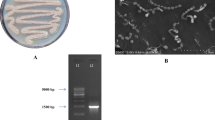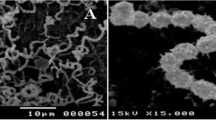Abstract
The present work studies the chemical constituents from marine-derived streptomyces 3320# and their antitumor activities. Then-BuOH extract of the ferment broth of 3320# was chromatographed on silica gel, Sephadex LH-20, ODS columns and HPLC to separate the compounds with antitoumor activities. Their structures were identified using IR, UV, NMR, MS spectroscopic techniques and compared with published data. The antitumor activities of the isolates were assayed using SRB method and flow cytometry assay, accompanied with the morphological observation of the cells under light microscope against mammalian tsFT210 cells. Ten compounds, cyclo-(Ala-Leu) 1, cyclo-(Ala-Ile) 2, cyclo-(Ala-Val) 3, cyclo-(Phe- Pro) 4, cyclo-(Phe-Gly) 5, cyclo-(Leu-Pro) 6, 1-methyl-1, 2, 3, 4-tetrahydro-β-carboline-3-carboxylic acid 7, N-(4-hydroxyphenethyl) acetamide 8, 4-methyoxy-1-(2-hydroxy) ethylbenzene 9 and uridine 10, were isolated from the ferment broth of streptomyces 3320#. Among them, compounds 6, 7, 8 and 10 showed potent cytotoxicity against the tsFT210 cell with the IC50 values of 3.6, 7.2, 5.2 and 1.6 mmol L−1, respectively. Compounds 8, 10 also exhibited apoptosis inducing activity under 2.0 mmol L−1. Compounds 6, 7, 8 and 10 are the principle bioactive constituents responsible for the antitumor activities of marine streptomyces 3320#. Compound 7 was isolated from this species for the first time.
Similar content being viewed by others
References
Airaksinen, M., and M. Kari, 1981. I. β-Carbolines, psychoactive compounds in the mammalian body. Part 2: Effects.Med. Biol.,59: 190–211.
Akira, I., 2000. Functional modulation ofEscherichia Coli RNA polymerase.Annu. Rev. Microbiol.,54: 499–518.
Arnold, B., A. Focella, and S. Teitel, 1973. Alkaloids in mammalian tissue. 3. Condensation of L-Tryptophan and L-5-Hydroxytryptophan with formaldehyde and acetaldehyde.J. Med. Chem.,16 (4): 418–420.
Caesar, F., K. Janssen, and E. Mutscher, 1969. Nigragillin, a new alkaloid from theAspergillus niger group. I. Isolation and structure elucidation of nigragillin and a dioxopiperazine.Pharm. Acta Helv.,44: 676–685.
Chen, Y. S., 1960. Study on the metabolic products of Roselinia necatrix. I. Isolation and characterization of several physiologically active, neutral substances.Bull. Agric. Chem. Soc. Jpn.,24: 372–377.
Cui, C. B., H. Wang, B. Han, and B. Cai, 2001. Elaiophylins, new cell cycle inhibitors and apoptosis inducers, produced byStreptomyces pseudoverticillus II. Structures and biological properties.Chin. Antibiot. J.,6: 165–171.
Ding, Z. T., J. Zhou, and N. H. Tan, 2000. Cyclic dipeptides from the root of psammosilene tunicoides.Chin. Trad. Herb. Drug.,31 (11): 803–806.
Du, K. P., R. Jiang, and B. Y. Li, 2001. IL-1R antagonists from microorganisms II. Studies on the metabolite of Streptomyces 660.Chin. Antibiot. J.,26 (6): 410–412.
Fenical, W., and P. R. Jensen, 1994. Strategies for the discovery of secondary metabolites from marine bacteria: ecological perspective.Annu. Rev. Microbiol.,48: 559–584.
Frits, S., C. G. Jan, and A. P. Rudolf, 1997. Isolation and characterization of the marine ultramicrobacteriumSphingomonas sp. strain RB2256.Microbiol. Rev.,20: 363–369.
Gearhart, D. A., M. A. Collins, J. M. Lee, and E. J. Neafsey, 2000. Increased β-Carboline 9N-methyltransferase activity in the frontal cortex in Parkinson's disease.Neurobiol. Dis.,7: 201–211.
Guo, S. X., X. M. Chen, and J. S. Yang, 2000. Studies on the chemical constituents ofMycena dendrobii.Chin. Pharm. J.,35 (6): 372–373.
Herraiz, T., 2001. Advances in the identification and analysis of the bioactive β-Carbolines alkaloids in food and biological samples.Curr. Top. Anal. Chem.,2: 171–177.
Husbands, S. M., R. A. Glennon, S. Gorgerat, R. Gough, R. Tyacke,et al., 2001. β-Carboline binding to imidazoline receptors.Drug Alcohol Depend.,64: 203–208.
John, P. H. T., P. S. Wriht, J. Hamaguchi, M. G. Lee, C. J. Norbury,et al., 1990. The tsFT210 cell line is a mouse G2 phase mutant with a temperature-sensitive CDC2 gene product.Cell,63: 313–324.
Ki-Hyeong, R., 2004. Cyclic dipeptides exhibit synergistic, broad spectrum antimicrobial effects and have anti-mutagenic properties.Int. J. Antimicrob. Agents.,24: 423–427.
Li, H. J., Y. C. Lin, and X. H. Liu, 2002. The peptides from endophytic fungus No. 2524 (I).ACTA Scientiarum Naturalium Univertatics Sunyatseni,41 (1): 100–104.
Madeline, A., A. R. Reed, and P. Crews, 1995. New and known diketopiperazines from the caribbean sponge.Calyx CF. Podatypa. J. Nat. Prod.,58(2): 201–205.
Maria, L., C. Rodrigues, M. J. Morcillo, M. Garrido, B. Benhanmu,et al., 1994. Stereospecificity in the reaction of tetrahydro-β-carboline-3-carboxylic acids with isocyanates kineticvs thermodynamic control.J. Org. Chem.,59: 1583–1585.
Skehan, P., R. Storeng, and D. Scudiero, 1990. New colorimetric cytotoxicity assay for anticancer drug screening.J. Natl. Cancer Inst.,82: 1107–1112.
Steven, G. T., P. R. Jensen, C. A. Kauffman, and W. Fenical, 1998. Aspergillamides A and B: Modified cytotoxic tripeptides produced by a marine fungus of the genusAspergillus.Tetrahedron,54: 13459–13466.
Xiong, J., J. Zhou, and H. F. Dai, 2002. Chemical constituents from phytolacca polyandra.Acta Bota Yunnanica,24 (3): 401–405.
Yin, W. Q., Y. C. Lin, and S. N. Zhou, 2002. The cyclopeptides from marine fungus 2516 from the South China Sea.ACTA Scientiarum Naturalium Univertatics Sunyatseni.,41 (4): 56–58.
Yu, A.-M., J. R. Idle, T. Herraiz, A. Kupfer, and F. J. Gonzalez, 2003. Screening for endogenous substrates reveals that CYP2D6 is a 5-methoxyindoleamine Odemethylase.Pharmacogenetics,13: 307–319.
Author information
Authors and Affiliations
Corresponding authors
Rights and permissions
About this article
Cite this article
Hong, R., Qianqun, G., Chengbin, C. et al. The cytotoxic constituents from marine-derived streptomyces 3320# . J. Ocean Univ. China 5, 75–81 (2006). https://doi.org/10.1007/BF02919379
Received:
Accepted:
Issue Date:
DOI: https://doi.org/10.1007/BF02919379




